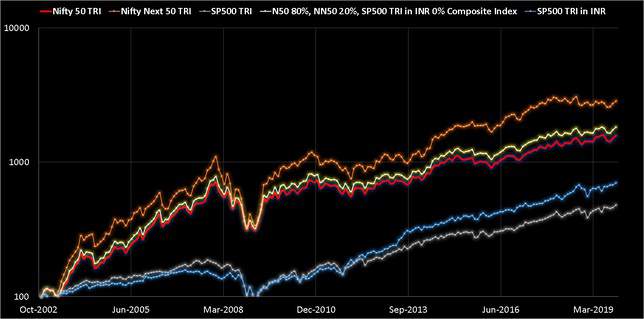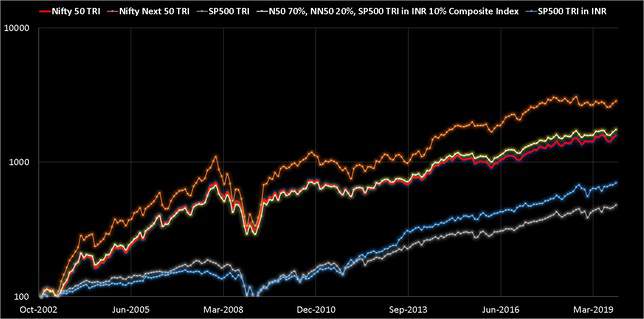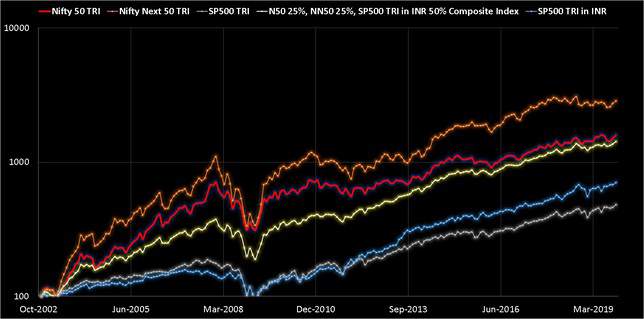Last Updated on December 29, 2021 at 5:10 pm
“Should I hold international stocks in my portfolio?” is a question that investors ask when returns in the local stock markets pale. In an Indian context, this typically means “buying US stocks”. So the questions to ask are, “should I buy US stocks?”, “if yes, how much should I hold?”
After the 2008 crisis, the US markets have had moved up significantly with only two -negative annual returns: -0.7% in 2015 and -6% in 2018. Almost all other annual returns were in two digits and three 20% plus years. Dividends are not included in this! Source: macrotrends
Although the Indian markets too moved up during this period and often much more, the Sensex fell by 23% in2011; In 2015 and 2016, Sensex did not beat a savings bank account and an FD in 2018. Naturally, this would make any investor look for greener pastures. Let us find out.
We start the analysis with a comparison of Nifty 50, Nifty Next 50 and S and P 500 (all dividends included) from Nov 2002. Unfortunately, this data set is rather small. There are several disadvantages associated with this, as discussed below. This is what we have, and we will have to work with it.
Join 32,000+ readers and get free money management solutions delivered to your inbox! Subscribe to get posts via email! (Link takes you to our email sign-up form)
🔥Want to create a complete financial plan? Learn goal-based investing? Exclusive access to our DIY tools? Increase your income with your skills? Enjoy massive discounts on our robo-advisory tool & courses! 🔥
Nifty 50 vs Nifty Next 50 vs S and P 500
The graph is in log scale, and a small portion of the S and P 500 (during the 2008 crisis) is cut off to make the rest of the plot clear.
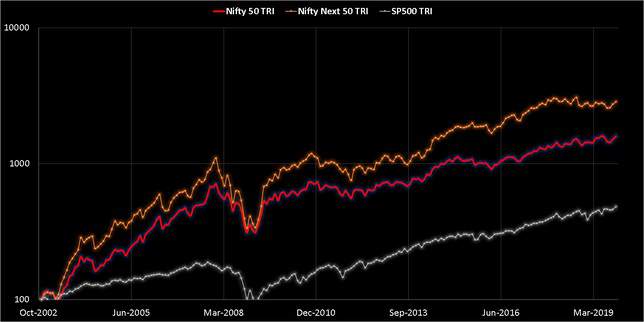 Just by looking at this, one might be tempted to conclude that “over the long term” it makes sense for an Indian investor to stick with the Indian market. This is reasonable with the caveat that the Indian market may not grow as much and as fast as it did in the past.
Just by looking at this, one might be tempted to conclude that “over the long term” it makes sense for an Indian investor to stick with the Indian market. This is reasonable with the caveat that the Indian market may not grow as much and as fast as it did in the past.
Not so fast! We need to dig deeper. Please be sure to see all the graphs and read the article in full. Also, there is something missing in the above chart. The S and P 500 is in USD while the Nifty indices are in INR. So when the S and P 500 is converted to INR, we get this.
Nifty 50 vs Nifty Next 50 vs S and P 500 (in INR)
 Many readers may be disappointed to note that the difference is not much between the S&P 500 and S&P500-INR. This is because the USD to INR conversion rate does not provide a significant gain over time (although it feels like it). This is the five-year rolling returns.
Many readers may be disappointed to note that the difference is not much between the S&P 500 and S&P500-INR. This is because the USD to INR conversion rate does not provide a significant gain over time (although it feels like it). This is the five-year rolling returns.
 We had discussed this earlier when reviewing Motilal Oswal Nasdaq 100 Fund of Fund: Why you should not invest!
We had discussed this earlier when reviewing Motilal Oswal Nasdaq 100 Fund of Fund: Why you should not invest!
Now we can construct different composite portfolios. We had earlier seen that 80% of Nifty 50 (n50) and 20% of NIfty Next 50 (nn50) could replicate the Nifty 100 well. See: Combine Nifty & Nifty Next 50 funds to create large, mid cap index portfolios.
We shall ignore taxes and exit loads. The portfolios are assumed to be rebalanced each month. Look for the movement of the white line. This is the composite portfolio. The evolution of the composite portfolios is shown below. This is monthly data so some features may be missing.
Composite 1: n50 (80%) + nn50(20%) + SP500-INR (0%)
 Composite 2: n50 (70%) + nn50(20%) + SP500-INR (10%)
Composite 2: n50 (70%) + nn50(20%) + SP500-INR (10%)
Composite 3: n50 (60%) + nn50(20%) + SP500-INR (20%)
Composite 4: n50 (50%) + nn50(25%) + SP500-INR (25%)
Composite 5: n50 (40%) + nn50(30%) + SP500-INR (30%)
Composite 6: n50 (25%) + nn50(25%) + SP500-INR (50%)
 Rolling Returns of the composite portfolios
Rolling Returns of the composite portfolios
We have a short window to work with here. Focus your attention on the dotted green line. That has no S&P 500 contribution. It perhaps ironic and even amusing that after the start of the late-2013 upward movement in the Indian stock market, composite portfolios have done better!
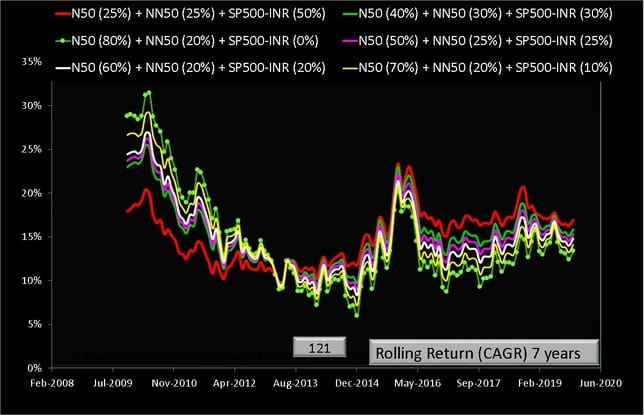 The red line with 50% of S&P 500 and 25% n50 and 25% nn50 has the lowest return spread. Based on this limited dataset, this balances return and risk well (based on a simple visual observation).
The red line with 50% of S&P 500 and 25% n50 and 25% nn50 has the lowest return spread. Based on this limited dataset, this balances return and risk well (based on a simple visual observation).
Yes, the above data suggests that “some exposure to S and P 500” will be beneficial to the investor. At the very least, it cannot hurt and will lower risk. However, there are two significant problems.
It is not easy to say “how much” is enough. Exposure to 50% of S and P 500 is simply too risky if there is a repeat of 2008. Say how about 20%? Yes, but this involves effort. Regular rebalancing ignoring taxes and exit loads. Anything lower will not help.
The second problem is, most investors who want returns, want only returns. They are either ignorant of risk management or unwilling to put in the effort and pay the taxes. The higher returns or lower risk that seems so natural in Excel is quite in reality.
What the investment options?
- Funds like Parag Parikh Long Term Equity Fund handle this quite well. There is not tax or exit load outgo and rebalancing to worry about. Also, the international portfolio is not restricted to US stocks. This IMO is the best-suited option for most investors. However, exposure to the fund must be significant to make a difference. Disclosure: the author is invested. See for details: My personal financial audit 2018
- Using international feeder funds will also work, the expense ratio (not considered above) can dampen returns. Investors with an eye on the Nasdaq 100 via Motilal Oswal Nasdaq 100 Fund of Fund will have to keep concentration risk in mind. See this comparison with S & P 500, for example.
- If your investment ticket size is large, you can consider directly buying S P 500 ETFs or US stocks. See this article by SEBI RIA Avinash Luthria: Open a low-cost international broking account and invest in low-cost foreign exchange-traded funds
- Exposure to the US market can be fruitful when it moves up but can hurt badly during downturns. Therefore investors must study past risk (not the returns, especially recent) before committing money. To profit from international diversification discipline and active management is essential.
🔥Enjoy massive discounts on our courses, robo-advisory tool and exclusive investor circle! 🔥& join our community of 7000+ users!
Use our Robo-advisory Tool for a start-to-finish financial plan! ⇐ More than 2,500 investors and advisors use this!
Track your mutual funds and stock investments with this Google Sheet!
We also publish monthly equity mutual funds, debt and hybrid mutual funds, index funds and ETF screeners and momentum, low-volatility stock screeners.





- Do you have a comment about the above article? Reach out to us on Twitter: @freefincal or @pattufreefincal
- Have a question? Subscribe to our newsletter using the form below.
- Hit 'reply' to any email from us! We do not offer personalized investment advice. We can write a detailed article without mentioning your name if you have a generic question.
Join 32,000+ readers and get free money management solutions delivered to your inbox! Subscribe to get posts via email! (Link takes you to our email sign-up form)
About The Author
 Dr M. Pattabiraman(PhD) is the founder, managing editor and primary author of freefincal. He is an associate professor at the Indian Institute of Technology, Madras. He has over ten years of experience publishing news analysis, research and financial product development. Connect with him via Twitter(X), Linkedin, or YouTube. Pattabiraman has co-authored three print books: (1) You can be rich too with goal-based investing (CNBC TV18) for DIY investors. (2) Gamechanger for young earners. (3) Chinchu Gets a Superpower! for kids. He has also written seven other free e-books on various money management topics. He is a patron and co-founder of “Fee-only India,” an organisation promoting unbiased, commission-free investment advice.
Dr M. Pattabiraman(PhD) is the founder, managing editor and primary author of freefincal. He is an associate professor at the Indian Institute of Technology, Madras. He has over ten years of experience publishing news analysis, research and financial product development. Connect with him via Twitter(X), Linkedin, or YouTube. Pattabiraman has co-authored three print books: (1) You can be rich too with goal-based investing (CNBC TV18) for DIY investors. (2) Gamechanger for young earners. (3) Chinchu Gets a Superpower! for kids. He has also written seven other free e-books on various money management topics. He is a patron and co-founder of “Fee-only India,” an organisation promoting unbiased, commission-free investment advice.Our flagship course! Learn to manage your portfolio like a pro to achieve your goals regardless of market conditions! ⇐ More than 3,000 investors and advisors are part of our exclusive community! Get clarity on how to plan for your goals and achieve the necessary corpus no matter the market condition is!! Watch the first lecture for free! One-time payment! No recurring fees! Life-long access to videos! Reduce fear, uncertainty and doubt while investing! Learn how to plan for your goals before and after retirement with confidence.
Our new course! Increase your income by getting people to pay for your skills! ⇐ More than 700 salaried employees, entrepreneurs and financial advisors are part of our exclusive community! Learn how to get people to pay for your skills! Whether you are a professional or small business owner who wants more clients via online visibility or a salaried person wanting a side income or passive income, we will show you how to achieve this by showcasing your skills and building a community that trusts and pays you! (watch 1st lecture for free). One-time payment! No recurring fees! Life-long access to videos!
Our new book for kids: “Chinchu Gets a Superpower!” is now available!


Must-read book even for adults! This is something that every parent should teach their kids right from their young age. The importance of money management and decision making based on their wants and needs. Very nicely written in simple terms. - Arun.Buy the book: Chinchu gets a superpower for your child!
How to profit from content writing: Our new ebook is for those interested in getting side income via content writing. It is available at a 50% discount for Rs. 500 only!
Do you want to check if the market is overvalued or undervalued? Use our market valuation tool (it will work with any index!), or get the Tactical Buy/Sell timing tool!
We publish monthly mutual fund screeners and momentum, low-volatility stock screeners.
About freefincal & its content policy. Freefincal is a News Media Organization dedicated to providing original analysis, reports, reviews and insights on mutual funds, stocks, investing, retirement and personal finance developments. We do so without conflict of interest and bias. Follow us on Google News. Freefincal serves more than three million readers a year (5 million page views) with articles based only on factual information and detailed analysis by its authors. All statements made will be verified with credible and knowledgeable sources before publication. Freefincal does not publish paid articles, promotions, PR, satire or opinions without data. All opinions will be inferences backed by verifiable, reproducible evidence/data. Contact information: To get in touch, use this contact form. (Sponsored posts or paid collaborations will not be entertained.)
Connect with us on social media
- Twitter @freefincal
- Subscribe to our YouTube Videos
- Posts feed via Feedburner.
Our publications
You Can Be Rich Too with Goal-Based Investing
 Published by CNBC TV18, this book is meant to help you ask the right questions and seek the correct answers, and since it comes with nine online calculators, you can also create custom solutions for your lifestyle! Get it now.
Published by CNBC TV18, this book is meant to help you ask the right questions and seek the correct answers, and since it comes with nine online calculators, you can also create custom solutions for your lifestyle! Get it now.Gamechanger: Forget Startups, Join Corporate & Still Live the Rich Life You Want
 This book is meant for young earners to get their basics right from day one! It will also help you travel to exotic places at a low cost! Get it or gift it to a young earner.
This book is meant for young earners to get their basics right from day one! It will also help you travel to exotic places at a low cost! Get it or gift it to a young earner.Your Ultimate Guide to Travel
 This is an in-depth dive into vacation planning, finding cheap flights, budget accommodation, what to do when travelling, and how travelling slowly is better financially and psychologically, with links to the web pages and hand-holding at every step. Get the pdf for Rs 300 (instant download)
This is an in-depth dive into vacation planning, finding cheap flights, budget accommodation, what to do when travelling, and how travelling slowly is better financially and psychologically, with links to the web pages and hand-holding at every step. Get the pdf for Rs 300 (instant download)